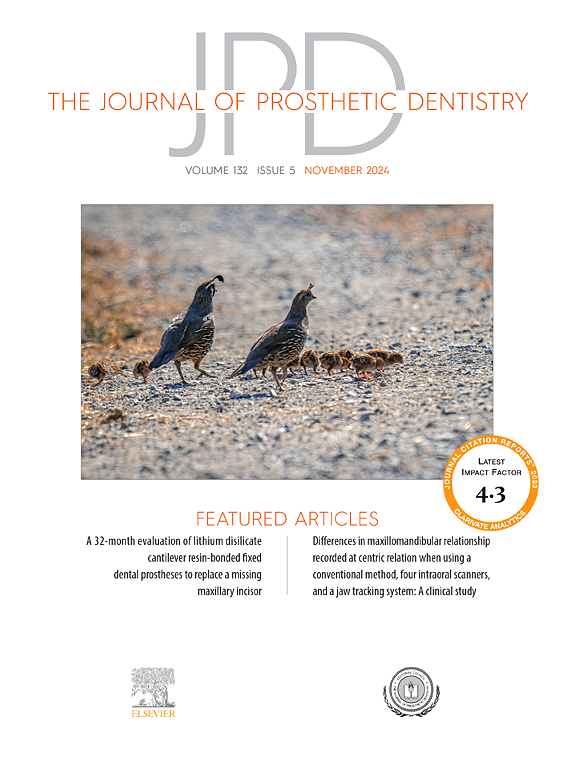Effect of ceramic type, cement shade, and ceramic thickness on the optical properties of the definitive restoration and the ability to mask a metal substructure
IF 4.8
2区 医学
Q1 DENTISTRY, ORAL SURGERY & MEDICINE
引用次数: 0
Abstract
Statement of problem
The influence of ceramic type, cement shade, and ceramic thickness on the final color of the restoration and its masking ability is unclear.
Purpose
The purpose of this in vitro study was to investigate the effect of the ceramic type and translucency parameters, ceramic thickness, and cement shade on the color of the definitive restoration and its masking ability.
Material and methods
A total of 120 ceramic specimens were fabricated in different thicknesses and divided into 10 groups: high translucency zirconia (HTZ 0.8, 1.2, 1.6 and 2 mm) (ZX2 98; Dental Direct), porcelain-fused-to-zirconia (PFZ1.5 and 2 mm) (DD Bio ZW iso color High Strength; Dental Direkt), monolithic low translucency lithium disilicate (LT 1 and 1.5 mm) (e.max; Ivoclar AG), bilayered glass-ceramic with a high opaque lithium disilicate (HO 1.5 and 2 mm) (e.max; Ivoclar AG). The color and translucency of the specimens were measured based on the L*a*b values and remeasured after applying resin cement evaluation pastes (Panavia V5 Try in paste; Kuraray Dental) in 3 colors: A2, opaque (O), or white (W) over 2 background materials (nickel chromium alloy or composite resin shade A2). The VITA Classic shade guide was used as the reference L*a*b value to evaluate the color matching capability of different ceramic-cement combinations. Color change (ΔEab) was measured, and the perceptibility threshold (PT) was set at 2.6 and the acceptability threshold (AT) at 5.5.
Results
The mean ΔE of the specimens ranged from 0.4 to 4.5. The type of ceramic significantly affected the color and translucency parameter (P<.001). In all groups, translucency decreased significantly with the increasing thickness of the ceramic (P<.001). According to the perceptibility threshold, the color of the nickel chromium background could be concealed by all 2 shades of cement (A2, opaque, and white). Nevertheless, the LT 1-mm, LT 1.5-mm, HTZ 0.8-mm, and HTZ 1.2-mm groups exhibited noticeable color changes when opaque cement was applied. Specimens with lower translucency parameters had better color matching with the A2 color. The HTZ 0.8-mm A2, LT 1-mm A2, and HTZ 0.8-mm W groups showed the least color match, with mean ΔE values of 12.4, 11.9, and 11.3, respectively. However, the PFZ 2-mm O and PFZ 2-mm W groups exhibited the best color match, with mean ΔE values of 1 and 1.4.
Conclusions
The thickness of the ceramic had a significant effect on its translucency. Moreover, the translucency of the ceramic influenced its masking ability and had a direct correlation with the color change in the presence of cement. Ceramic materials with an opaque framework had lower translucency but better color matching with the reference shade.
陶瓷类型、水泥阴影和陶瓷厚度对最终修复的光学特性和掩盖金属子结构的能力的影响。
问题陈述:陶瓷类型、水泥色度、陶瓷厚度对修复体最终颜色及其遮盖能力的影响尚不清楚。目的:探讨陶瓷类型和半透明参数、陶瓷厚度、水泥色度对最终修复体颜色和遮蔽能力的影响。材料与方法:制作120个不同厚度的陶瓷试样,分为10组:高半透明氧化锆(HTZ 0.8、1.2、1.6和2 mm) (ZX2 98;牙科直接),烤瓷-氧化锆(PFZ1.5和2mm) (DD Bio ZW等色高强度;Dental direct),单片低半透明二硅酸锂(lt1和1.5 mm) (e.max;Ivoclar AG),双层玻璃陶瓷,具有高不透明的二硅酸锂(HO 1.5和2 mm) (e.max;Ivoclar AG)。根据L*a*b值测量试样的颜色和透明度,并在膏体中应用树脂水泥评价膏体(Panavia V5 Try;3种颜色:A2,不透明(O)或白色(W), 2种背景材料(镍铬合金或复合树脂遮光A2)。使用VITA Classic色度指南作为参考L*a*b值来评估不同陶瓷-水泥组合的配色能力。测量颜色变化(ΔEab),感知阈值(PT)设为2.6,可接受阈值(at)设为5.5。结果:标本的平均ΔE值在0.4 ~ 4.5之间。结论:陶瓷的厚度对其半透明性有显著影响。此外,陶瓷的半透明性影响其遮盖能力,并与水泥存在下的颜色变化直接相关。带有不透明框架的陶瓷材料具有较低的半透明性,但与参考阴影的颜色匹配更好。
本文章由计算机程序翻译,如有差异,请以英文原文为准。
求助全文
约1分钟内获得全文
求助全文
来源期刊

Journal of Prosthetic Dentistry
医学-牙科与口腔外科
CiteScore
7.00
自引率
13.00%
发文量
599
审稿时长
69 days
期刊介绍:
The Journal of Prosthetic Dentistry is the leading professional journal devoted exclusively to prosthetic and restorative dentistry. The Journal is the official publication for 24 leading U.S. international prosthodontic organizations. The monthly publication features timely, original peer-reviewed articles on the newest techniques, dental materials, and research findings. The Journal serves prosthodontists and dentists in advanced practice, and features color photos that illustrate many step-by-step procedures. The Journal of Prosthetic Dentistry is included in Index Medicus and CINAHL.
 求助内容:
求助内容: 应助结果提醒方式:
应助结果提醒方式:


